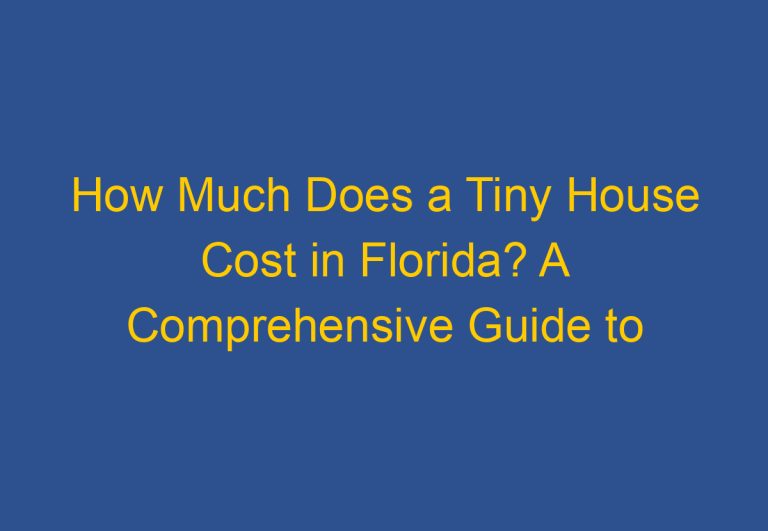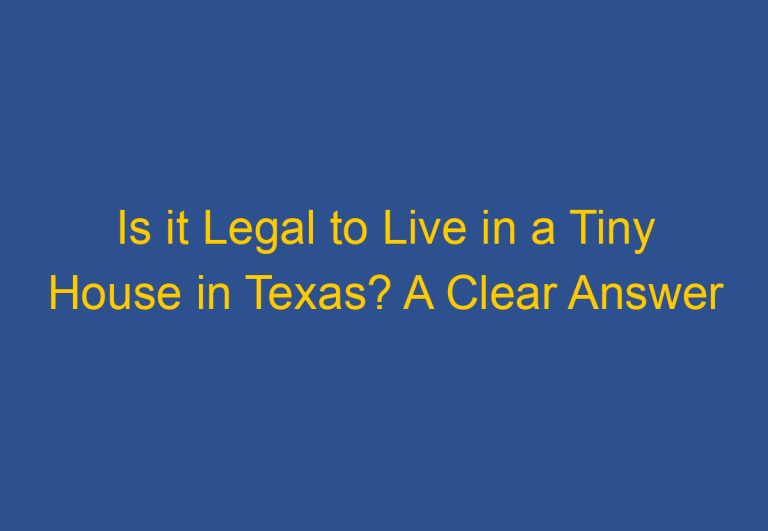Where Are Tiny Homes Legal in the US? A Comprehensive Guide
Tiny homes have been gaining popularity in recent years as a way to live a simpler and more sustainable lifestyle. However, with the rise of tiny homes comes the question of where they are legal in the United States. The answer to this question is not straightforward, as tiny home regulations vary by state, city, and even neighborhood.
Generally speaking, many states have lenient regulations when it comes to tiny homes on wheels. California, for example, is known for its thriving tiny home community and relatively relaxed building codes. Other states that are considered friendly to tiny homes include Colorado, Oregon, Texas, and Florida. However, it is important to note that even in these states, regulations may vary depending on the specific location and type of tiny home being built.
Legality and Zoning Laws for Tiny Homes in the US
The tiny house movement has gained popularity in recent years, with many people choosing to live in smaller homes to reduce their environmental footprint and simplify their lives. However, the legality and zoning laws for tiny homes vary widely across the United States.
Overview of Zoning Laws and Regulations
Zoning laws and regulations dictate where and how tiny homes can be built and occupied. These laws are typically set at the city or town level and can vary greatly from one jurisdiction to another. In some areas, tiny homes may be allowed as accessory dwelling units (ADUs) or on wheels as recreational vehicles (RVs), while in others, they may be prohibited altogether.
State-Specific Tiny Home Legality
The legality of tiny homes varies widely from state to state. Some states, such as California, Texas, and Florida, have relatively lenient zoning laws and regulations that allow for the development of tiny home communities. Other states, such as Oregon, Washington, and New York, have more restrictive laws and may only allow tiny homes as ADUs or on wheels as RVs.
Several states, including North Dakota, Virginia, Maine, Arizona, Minnesota, West Virginia, Alaska, Colorado, and Georgia, have passed laws specifically addressing tiny homes. These laws may define what constitutes a tiny home, establish building standards, or provide exemptions from certain zoning regulations.
Tiny Houses on Wheels and RV Status
Many tiny homes are built on wheels, which can complicate their legal status. In some jurisdictions, tiny homes on wheels may be considered RVs and subject to RV regulations. In others, they may be considered permanent structures and subject to building codes and zoning regulations for traditional homes.
It is important for those interested in building or living in a tiny home to research the zoning laws and regulations in their area. They should also be aware of the building codes and permit requirements for their specific type of tiny home, whether it is on wheels or a permanent structure.
Building Codes and Community Integration
Adherence to Building Codes and Safety Standards
When building a tiny home, it is important to adhere to building codes and safety standards to ensure that the structure is safe and habitable. While each state has its own set of guidelines for tiny homes, the International Residential Code (IRC) provides a set of minimum standards that can be used as a reference.
One of the main considerations when building a tiny home is the minimum square footage. Many states require a minimum of 400 square feet for a residential structure, while others allow for smaller homes. In addition to square footage, ceiling height, emergency exits, and other safety features must also be taken into account.
It is important to note that building codes and safety standards are in place to protect the occupants of the tiny home as well as the surrounding community. Failure to adhere to these standards can result in legal consequences and safety hazards.
Development of Tiny House Communities
The development of tiny house communities is a growing trend in the United States. These communities provide a sense of community and support for those living in tiny homes. Many cities and counties have begun to allow for the development of tiny home communities and accessory dwelling units (ADUs).
For example, Fresno, California has recently passed an ordinance allowing for the development of tiny home communities. Pima County, Arizona allows for the development of ADUs on residential properties. Burleigh County, North Dakota has also recently passed an ordinance allowing for the development of tiny home communities.
The development of these communities is important for the integration of tiny homes into mainstream housing markets. By advocating for changes in zoning laws and building codes, local advocacy groups are working to promote the acceptance and integration of tiny homes into communities.
In conclusion, adherence to building codes and safety standards is crucial when building a tiny home. The development of tiny home communities is also an important step in the integration of tiny homes into mainstream housing markets. By working together, we can create safe and supportive communities for those living in tiny homes.
Frequently Asked Questions
What states have the most lenient regulations for tiny house living?
Some states have more lenient regulations for tiny house living than others. For example, Texas, Georgia, and Virginia are known for being more accommodating to tiny homes. These states have established tiny house communities, builders, and regulations that make it easier for people to live in tiny homes.
Are there any states that offer incentives or pay you to build a tiny house?
There are some states that offer incentives or programs for people who want to build tiny homes. For example, Detroit, Michigan has a program called “Detroit Tiny Homes” that offers vacant lots for people to build their own tiny homes. Additionally, some states offer tax incentives or grants to people who build tiny homes, such as Colorado and Oregon.
What are the zoning and building requirements for tiny homes in different states?
Zoning and building requirements for tiny homes vary by state and even by city. Some states, such as California and Washington, have established regulations for accessory dwelling units (ADUs) that also apply to tiny homes. Other states may have different requirements, such as minimum square footage or height restrictions. It is important to research local and state regulations before building or living in a tiny home.
Can you live in a tiny house on wheels legally in the United States?
Living in a tiny house on wheels legally in the United States can be a bit tricky. Some states allow it, while others do not. For example, California, Colorado, and Texas have more relaxed regulations for tiny homes on wheels, while other states such as New York and New Jersey have stricter regulations. It is important to research local and state regulations before building or living in a tiny home on wheels.
What is the maximum allowable size for a tiny house to be considered legal?
The maximum allowable size for a tiny house to be considered legal varies by state and even by city. For example, in California, a tiny house on wheels can be no larger than 400 square feet, while in Washington, a tiny house on wheels can be no larger than 200 square feet. It is important to research local and state regulations before building or living in a tiny home.
Do you need special permits to build or reside in a tiny house on your own property?
In most cases, you will need special permits to build or reside in a tiny house on your own property. These permits may include building permits, zoning permits, and occupancy permits. It is important to research local and state regulations before building or living in a tiny home on your own property.










